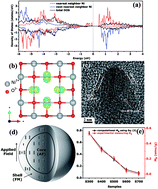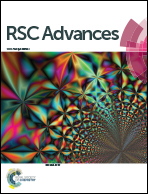A series of unexpected ferromagnetic behaviors based on the surface-vacancy state: an insight into NiO nanoparticles with a core–shell structure
Abstract
Antiferromagnetic nanoparticles as ultimate low-dimensional materials potentially give novel magnetic properties that differ from their bulk form due to strong quantum and surface effects. Herein, we propose that the observed anomalous ferromagnetic behavior of NiO nanoparticles is due to the formation of a ferromagnetic particle shell that is oxygen-vacancy related. A novel self-consistent estimation of the saturation magnetization further confirmed our proposal. The samples, synthesized by a thermal decomposition method, exhibit diversely anomalous ferromagnetic behavior, such as hysteresis curves, large coercivities, exchange bias and spin-glass behavior. A large saturation magnetization of 0.536 emu g−1 exists in the 6 nm NiO sample and it is found to decrease with increasing crystal size. Neither impurity element nor change of valence state has been found in the samples, through X-ray photoelectron, X-ray diffraction or selected-area electron diffraction measurements. Remarkably, a large amount of oxygen vacancies exists, which was verified by X-ray photoelectron spectrum fitting results and Raman spectroscopy. A post-hydrogen-annealing process strongly elevates ferromagnetic ordering, as a result of surface defect enhancement. Moreover, our estimation of the saturation magnetization based on first principle calculation results is in agreement with the experimental conclusion, which reveals the significance of surface states in mediating anomalous magnetic properties in low-dimensional antiferromagnetic materials.


 Please wait while we load your content...
Please wait while we load your content...